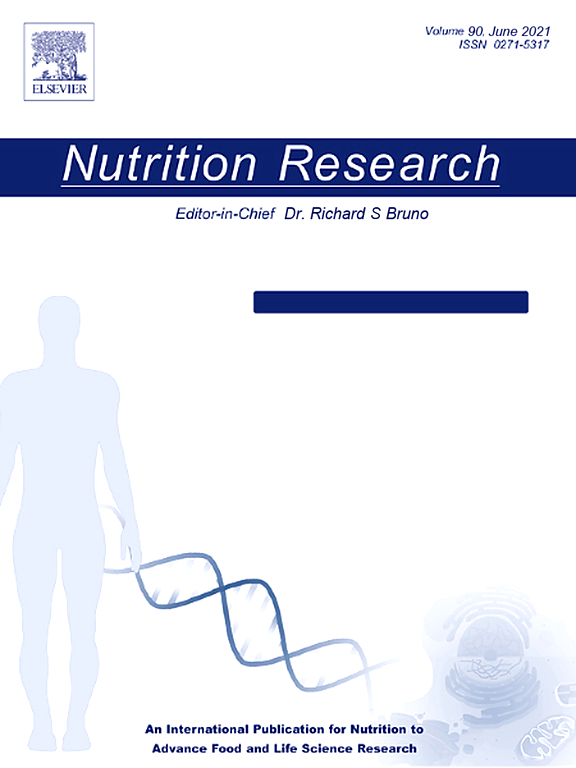Palm and interesterified palm oil-enhanced brown fat whitening contributes to metabolic dysfunction in C57BL/6J mice
IF 3.1
3区 医学
Q2 NUTRITION & DIETETICS
引用次数: 0
Abstract
Palm oil is widely used in the food industry owing to its high stability and versatility. The interesterified version has been used as an alternative to oils rich in trans fatty acids. However, the health effects of these vegetable oils are not yet fully understood. We hypothesized that the consumption of palm oil (noninteresterified and interesterified), even without excessive amounts of energy and lipids in the diet, could lead to morphofunctional changes in brown adipose tissue (BAT). To this end, male C57BL/6J mice were divided into 3 dietary groups (n = 10 each): soybean oil (SO), palm oil (PO), and interesterified palm oil (IPO) for 10 weeks. The PO and IPO groups had significant increases in the visceral fat mass and interscapular BAT (iBAT) lipid content. In iBAT, the PO and IPO groups showed lower mRNA expression of Ucp1, Adrb3, and Pgc1a, while the PO also showed lower mRNA levels of Ppara and Ampk, and the IPO showed lower Prdm16 expression. Moreover, PO had higher Il6 expression and lower catalase activity, while the IPO showed an upregulated Tnfa expression and lower catalase activity, but higher antioxidant activity of the glutathione peroxidase (GPx) enzyme. The consumption of PO and IPO had negative effects on weight and body fat, including the impairment of iBAT function. Our findings give rise to apprehensions regarding the safety and consequences of consuming PO and IPO for energy metabolism.

棕榈和酯化棕榈油增强棕色脂肪增白有助于C57BL/6J小鼠代谢功能障碍。
棕榈油因其高稳定性和多功能性而广泛应用于食品工业。其酯化版本已被用作富含反式脂肪酸的油的替代品。然而,这些植物油对健康的影响尚不完全清楚。我们假设,即使饮食中没有过量的能量和脂质,食用棕榈油(非酯化和酯化)也可能导致棕色脂肪组织(BAT)的形态功能改变。为此,将雄性C57BL/6J小鼠分为大豆油(SO)、棕榈油(PO)和互化棕榈油(IPO) 3组,每组n = 10,饲喂10周。PO和IPO组内脏脂肪量和肩胛间BAT (iBAT)脂质含量显著增加。在iBAT中,PO组和IPO组Ucp1、Adrb3和Pgc1a mRNA表达水平较低,PO组Ppara和Ampk mRNA表达水平较低,IPO组Prdm16表达水平较低。此外,PO具有较高的Il6表达和较低的过氧化氢酶活性,而IPO具有较高的Tnfa表达和较低的过氧化氢酶活性,但具有较高的抗氧化活性谷胱甘肽过氧化物酶(GPx)酶。PO和IPO的消耗对体重和体脂有负面影响,包括iBAT功能的损害。我们的研究结果引起了人们对摄入PO和IPO对能量代谢的安全性和后果的担忧。
本文章由计算机程序翻译,如有差异,请以英文原文为准。
求助全文
约1分钟内获得全文
求助全文
来源期刊

Nutrition Research
医学-营养学
CiteScore
7.60
自引率
2.20%
发文量
107
审稿时长
58 days
期刊介绍:
Nutrition Research publishes original research articles, communications, and reviews on basic and applied nutrition. The mission of Nutrition Research is to serve as the journal for global communication of nutrition and life sciences research on diet and health. The field of nutrition sciences includes, but is not limited to, the study of nutrients during growth, reproduction, aging, health, and disease.
Articles covering basic and applied research on all aspects of nutrition sciences are encouraged, including: nutritional biochemistry and metabolism; metabolomics, nutrient gene interactions; nutrient requirements for health; nutrition and disease; digestion and absorption; nutritional anthropology; epidemiology; the influence of socioeconomic and cultural factors on nutrition of the individual and the community; the impact of nutrient intake on disease response and behavior; the consequences of nutritional deficiency on growth and development, endocrine and nervous systems, and immunity; nutrition and gut microbiota; food intolerance and allergy; nutrient drug interactions; nutrition and aging; nutrition and cancer; obesity; diabetes; and intervention programs.
 求助内容:
求助内容: 应助结果提醒方式:
应助结果提醒方式:


